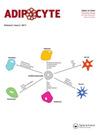Oncostatin M promotes lipolysis in white adipocytes
IF 3.5
4区 生物学
Q2 ENDOCRINOLOGY & METABOLISM
引用次数: 1
Abstract
ABSTRACT Oncostatin M (OSM) is a member of the glycoprotein 130 cytokine family that is involved in chronic inflammation and increased in adipose tissue under obesity and insulin resistance. OSM was shown to inhibit adipogenesis, suppress browning, and contribute to insulin resistance in cultured white adipocytes. In contrast, OSM may have a metabolically favourable role on adipocytes in mouse models of obesity and insulin resistance. However, a putative role of OSM in modulating lipolysis has not been investigated in detail to date. To address this, cultured white adipocytes of mouse or human origin were exposed to 10 or 100 ng/ml of OSM for various time periods. In murine 3T3-L1 cells, OSM stimulation directly activated hormone-sensitive lipase (HSL) and other players of the lipolytic machinery, and dose-dependently increased free fatty acid and glycerol release. In parallel, OSM attenuated insulin-mediated suppression of lipolysis and induced phosphorylation of serine-residues on the insulin receptor substrate-1 (IRS1) protein. Key experiments were verified in a second murine and a human adipocyte cell line. Inhibiton of extracellular signal-regulated kinase (ERK)-1/2 activation, abolished OSM-mediated HSL phosphorylation and lipolysis. In conclusion, OSM signalling directly promotes lipolysis in white adipocytes in an ERK1/2-dependent manner.抑素M促进白色脂肪细胞的脂肪分解
肿瘤抑制素M (Oncostatin M, OSM)是糖蛋白130细胞因子家族的一员,参与肥胖和胰岛素抵抗下脂肪组织的慢性炎症和增加。在培养的白色脂肪细胞中,OSM被证明可以抑制脂肪生成,抑制褐变,并有助于胰岛素抵抗。相反,OSM可能对肥胖和胰岛素抵抗小鼠模型中的脂肪细胞具有代谢有利作用。然而,迄今为止,OSM在调节脂肪分解中的假定作用尚未得到详细的研究。为了解决这个问题,将培养的小鼠或人类白色脂肪细胞暴露于10或100 ng/ml的OSM中不同时间。在小鼠3T3-L1细胞中,OSM刺激直接激活激素敏感脂肪酶(HSL)和其他脂溶机制,并剂量依赖性地增加游离脂肪酸和甘油的释放。同时,OSM减弱胰岛素介导的脂肪分解抑制和诱导胰岛素受体底物-1 (IRS1)蛋白丝氨酸残基磷酸化。在第二种小鼠和人类脂肪细胞系中验证了关键实验。抑制细胞外信号调节激酶(ERK)-1/2的激活,消除osm介导的HSL磷酸化和脂肪分解。综上所述,OSM信号以erk1 /2依赖的方式直接促进白色脂肪细胞的脂肪分解。
本文章由计算机程序翻译,如有差异,请以英文原文为准。
求助全文
约1分钟内获得全文
求助全文
来源期刊

Adipocyte
Medicine-Histology
CiteScore
6.50
自引率
3.00%
发文量
46
审稿时长
32 weeks
期刊介绍:
Adipocyte recognizes that the adipose tissue is the largest endocrine organ in the body, and explores the link between dysfunctional adipose tissue and the growing number of chronic diseases including diabetes, hypertension, cardiovascular disease and cancer. Historically, the primary function of the adipose tissue was limited to energy storage and thermoregulation. However, a plethora of research over the past 3 decades has recognized the dynamic role of the adipose tissue and its contribution to a variety of physiological processes including reproduction, angiogenesis, apoptosis, inflammation, blood pressure, coagulation, fibrinolysis, immunity and general metabolic homeostasis. The field of Adipose Tissue research has grown tremendously, and Adipocyte is the first international peer-reviewed journal of its kind providing a multi-disciplinary forum for research focusing exclusively on all aspects of adipose tissue physiology and pathophysiology. Adipocyte accepts high-profile submissions in basic, translational and clinical research.
 求助内容:
求助内容: 应助结果提醒方式:
应助结果提醒方式:


